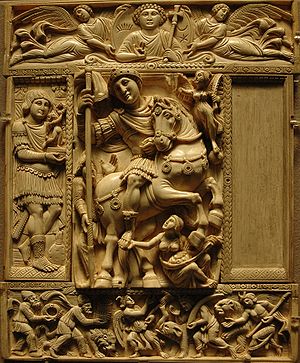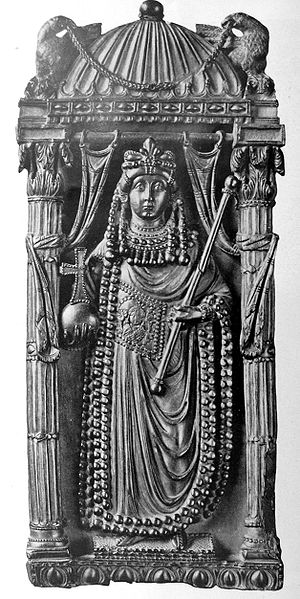
Imperial diptych
Encyclopedia


Late Antiquity
Late Antiquity is a periodization used by historians to describe the time of transition from Classical Antiquity to the Middle Ages, in both mainland Europe and the Mediterranean world. Precise boundaries for the period are a matter of debate, but noted historian of the period Peter Brown proposed...
, an imperial diptych is a theoretical type of ivory
Ivory
Ivory is a term for dentine, which constitutes the bulk of the teeth and tusks of animals, when used as a material for art or manufacturing. Ivory has been important since ancient times for making a range of items, from ivory carvings to false teeth, fans, dominoes, joint tubes, piano keys and...
diptych
Diptych
A diptych di "two" + ptychē "fold") is any object with two flat plates attached at a hinge. Devices of this form were quite popular in the ancient world, wax tablets being coated with wax on inner faces, for recording notes and for measuring time and direction.In Late Antiquity, ivory diptychs with...
, made up of two leaves of five panels each and each with a central panel representing the emperor or empress. They are so-named in contrast to consular diptych
Consular diptych
In Late Antiquity a consular diptych was a particular type of diptych which could function as a writing tablet but was also intended as a deluxe commemorative object, commissioned by a consul ordinarius and then distributed to reward those who had supported his candidature as...
s. They were produced as unique examples, whereas each consular diptych was produced in large numbers to offer to the emperor on certain occasions, principally a nobleman's entry to the consulship.
No complete example of an imperial diptych survives and so their existence is contested. The ivories specialist R. Delbrück has theorised that the 19 surviving fragments of ivory panels which clearly do not belong to the usual type of consular diptychs constitute evidence of imperial diptychs, despite having many characteristics in common with consular diptychs. The iconography of these diptychs obeys a stereotypical scheme, as illustrated by the Barberini ivory
Barberini ivory
The Barberini ivory is a Byzantine ivory leaf from an imperial diptych dating from Late Antiquity, now in the Louvre in Paris. It is carved in the style known as late Theodosian, representing the emperor as triumphant victor...
, which is the best example of the posited type - an imperial diptych's programme would be made up of a central figure of the emperor or empress, figures of dignitaries on its side panels, an upper register showing a personification of Constantinople or a medallion with a bust of Christ and a lower register showing barbarians making offerings to the emperor. However, the fact that the Barberini ivory was almost certainly not a diptych, but some kind of imperial icon
Icon
An icon is a religious work of art, most commonly a painting, from Eastern Christianity and in certain Eastern Catholic churches...
without a second panel is a serious argument against the existence of the imperial diptych type.
The two panels representing the empress Ariadne
Ariadne (empress)
Aelia Ariadne was the Empress consort of Zeno and Anastasius I of the Byzantine Empire.-Family:Ariadne was a daughter of Leo I and Verina. Her mother was a sister of Basiliscus....
, in the Bargello
Bargello
The Bargello, also known as the Bargello Palace or Palazzo del Popolo is a former barracks and prison, now an art museum, in Florence, Italy.-Terminology:...
in Florence
Florence
Florence is the capital city of the Italian region of Tuscany and of the province of Florence. It is the most populous city in Tuscany, with approximately 370,000 inhabitants, expanding to over 1.5 million in the metropolitan area....
and the Kunsthistorisches Museum
Kunsthistorisches Museum
The Kunsthistorisches Museum is an art museum in Vienna, Austria. Housed in its festive palatial building on Ringstraße, it is crowned with an octagonal dome...
in Vienna
Vienna
Vienna is the capital and largest city of the Republic of Austria and one of the nine states of Austria. Vienna is Austria's primary city, with a population of about 1.723 million , and is by far the largest city in Austria, as well as its cultural, economic, and political centre...
, also belong to the hypothesied imperial diptych type. They are the only central panels of such a diptych (other than the Barberini ivory) to survive, since all other fragments of such diptychs are from side panels.

